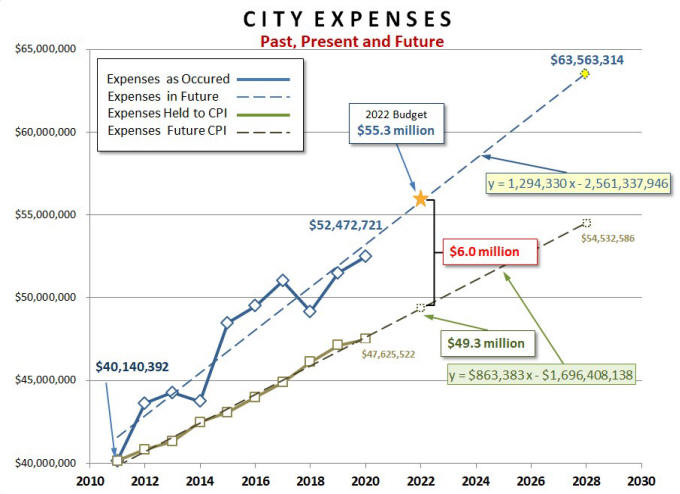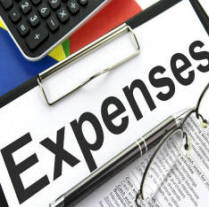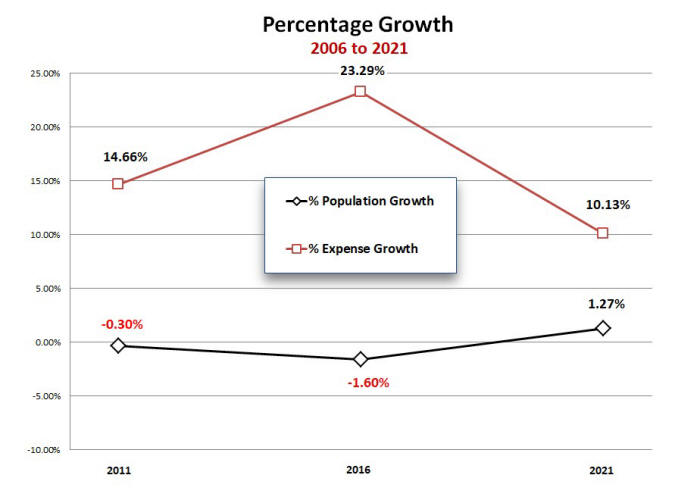 |
| Expense Growth - Past, Present and Future source: Owen Sound Audit Financial Statements |
Excessive Growth in City Budgets – Part I

City expenses increased by $12.3 million or 30.7% between 2011 and 2020. This was well beyond the 18.3% increase in the Consumer Price Index (CPI) for the same period. As shown in this graph below, the increase in expenses followed a relatively linear path during the study period. The linear projection of expenses, shown as dashed lines, into the future shows that expenses have been increasing steadily at a rate of nearly $1.29 million per year. If Council continues on this path, expenses are projected to reach $63.5 million in the next 6 years. This represents an increase of $23.5 million from the $40.1 million they were in 2011
To verify the
accuracy of our projection we can use the equation for Trend Line, shown on the
chart, to calculate a point on the Trend Line for 2022. The projected result for
2022 is $55,797,314.
 |
| Expense Growth - Past, Present and Future source: Owen Sound Audit Financial Statements |
The budget approved by Council for 2022 has expenses of $55.3 million which is shown on the above chart with a gold star. Although this is slightly lower than that estimated by the Trend Line, it does give us a high level of confidence in the accuracy of the Trend Line established from the 2011 to 2020 data.
 |
| Departmental Expense Growth source: Owen Sound Audit Financial Statements |
As shown in the graph above, the vast majority of the expense increases are the
result of the large annual increases that have occurred in two areas, Protective
Services and Transportation. The cost of Protective Services has historically
been increasing at an average rate of $433 thousand per year and the cost of
Transportation has been increasing at $421 thousand per year. These two cost
centers alone account for 66% of the total expense increase rate of $1,294,334
per year.
The gray dashed line shown on the graph is an indication of how inflation
changed during the study period. Trend lines are shown by the dashed lines for
each of department. Departments with a slope greater than the gray line are
growing at a rate faster than inflation. Departments with a slope that is less
than the gray line, such as Government Services are growing at a rate that is
less than inflation. We see that in addition to Government Services, Planning
and Development and Health Services showed only moderate growth during the study
period.
 |
| Growth of City Expenses Relative to Population Growth Sources: Statistics Canada, and Financials |
The census is taken every five years. From 2006 to 2011 our population
contracted by 0.30%. During the same period city expenses grew from $35.0
million to $40.1 million or an alarming 14.66%. Also, between 2011 and
2016 the population again contracted by 1.60%. At the same time city expenses
grew from $40.1 million to $49.5 or by a whopping 23.29% on top of the previous
increase.
The net result over this ten year period between 2006 and 2011 was that expenses grew by $14.5 million from $35.0 million to $49.5 million or 41.4%. How can it cost 41.4% more to run the city during this ten year period when the population contracted by 1.89 percent? In total, the cost to run the city grew by $19.5 million from $35.0 million in 2006 to $54.5 million in 2021. At the same time Owen Sound's population was reduced by 141 residents from 21,753 in 2006 to 21,612 in 2021.
It is unreasonable to expect expenses to have been frozen at the 2006 level just because our population didn't grow. As we all know, the cost of products and services go up a little every year. It would have been reasonable for city expenses to grow at the same rate as inflation. Had the annual increases in expenses been capped at inflation, the total expenses in 2021 would have been $48.5 million instead of the $54.5 million that actually occurred. That puts the excessive growth in expenses to be in the order of $6.0 million for the period 2006 to 2021. Approximately, 76% of this would have affected the total tax levy which also includes a portion going to the County. That’s a difference of about $4.5 million in the tax levy. A generous approximation is that $350,000 represents a one percent increase in the tax levy. So had the city held the annual increase in expenses to inflation over the past 11 years, the tax levy would be approximately 13% or $4.2 million less than the $32.5 million that it is today.